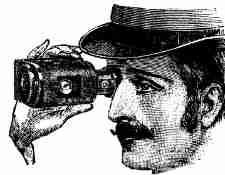Toronto. Dry plate technology introduced ‘detective’ cameras – hand held cameras disguised as satchels, purses, boxes, etc. usable without the give-away of a tripod. Once potential subjects recognized this new variation of camera, another means of secrecy had to be created.
One logical means was a device to let the photographer seem to look in one direction, while actually photographing in another. Various cameras emerged with the viewfinder and taking lens at right angles to the stance of the photographer. Leitz even had an accessory viewer for the Leica in 1929 called a WINKO. Tiny prisms allowed the viewfinder and rangefinder to function with the camera held at a 90 degree angle.
Bill Belier’s column, “A Treasure From My Collection …” in issue 25-3, shows a camera from the late Ron Anger’s collection in the article titled, “THE 1924 ARGUS MONOCULAR CAMERA FROM CONTESSA–NETTEL”.
“Bill begins the article. ‘My name is Anger… Ron Anger’. And so it was that we met in September 1977 when he responded to a classified ad that I had placed in a Toronto newspaper seeking to buy old cameras. He identified himself as a fellow collector and invited me to a meeting with other old-camera enthusiasts to be held the following Wednesday. I was unaware that a collector’s group had been formed in 1974, until my new friend introduced me to the P.H.S.C. that evening.
“How appropriate that Ron’s membership number is 007. This month’s featured ‘treasure’ is just the type of camera that would have been designed for James Bond, had Ian Fleming’s British secret agent been around in 1924, the year that Contessa-Nettel introduced the Argus.
“Described as a monocular spy camera, the Argus resembles a miniature leather covered telescope. The format is 4.5×6 cm for cut film and the lens is a CZJ [Carl Zeiss, Jena] Tessar 5.5 cm, f:4.5 with shutter speeds of T, B, and 1/25 to 1/100. Both viewfinder and taking lenses are positioned at 90º, which of course, is the main feature of the camera.
“When Contessa-Nettel became part of the Zeiss Ikon group of companies in 1926, the Argus underwent a name change and became the Ergo. Essentially the cameras are identical with the exception of the “trap door” cover concealing the lens. The original Argus (as illustrated) has a rectangular cover, the Ergo has a circular cover.
“During the transitionary period there probably was a parts exchange, as some later Argus models appear with the circular cover while some early Ergo models have the rectangular cover. And why a name change? Perhaps some knowledgeable Zeiss historian could enlighten us.” …
Members can read all this illustrated article in the issue 25-3 pdf file on the free members-only DVD/thumb drive. Joining is easy, just follow the instructions for cheque (MEMBERSHIP above) or credit card etc. (Membership right). Send any membership questions you have to Lilianne at member@phsc.ca.









